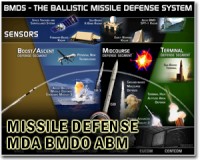| . |  |
. |
Tel Aviv, Israel (UPI) Nov 2, 2010 Israel's military has begun constructing a third battery of long-range, high-altitude Arrow anti-missile interceptors near Tel Aviv to boost defenses against Iranian ballistic missiles. The planned deployment, and a scramble to develop and install other systems to counter short- and medium-range missiles and rockets, underlines the Jewish state's growing fears that its cities and towns face a missile bombardment of unprecedented scale and ferocity. The existing batteries of Arrow-2 interceptors, jointly produced by state-owned Israel Aerospace Industries and the Boeing Co., are deployed at an air force base in southern Israel and another near the city of Hadera in the north. Additional batteries are expected to be added over the next decade. "The new battery provides another layer of protection and gives the air force the ability to launch more than one interceptor at an incoming target," The Jerusalem Post quoted a senior Israeli officer as saying Thursday. The new battery will be controlled by the Citron Tree fire-control command center developed along with the Arrow over the last two decades. It will also control the other two batteries now in place. "It will be able to control all of the other batteries from the new position so if there's a malfunction at the other sites we have a backup," the senior official explained. "In general, the new battery helps us disperse our assets and enables us to continue operating defense systems even if some of the other batteries are damaged during a conflict." IAI and Boeing are developing an advanced Arrow-3 missile under a program that began in 1988 and has absorbed around $1 billion in direct U.S. funding. The Israel missile defense system was linked to a U.S. FBX-T phased array radar system built by Raytheon, popularly known as the X-band, installed in 2009 at the Nevatim air base in the southern Negev. That is hooked up to the U.S. Joint Tactical Ground Station in Europe, which shares data instantaneously with Israel's Arrow system. The X-band installation at Nevatim is manned by a unit of the U.S. European Command and the Israelis aren't happy at their lack of control over the system. But this has been dampened by the enormous improvement the X-band provides for Israel's missile detection capabilities. The Raytheon system can detect a flying object the size of a baseball at a distance of 2,940 miles and establish its speed and trajectory for the Arrow. This means the X-band can spot an Iranian Shehab-3b ballistic missile, currently the mainstay of Tehran's strategic forces, 5.5 minutes after launch. That's about halfway through the 11-minute flight from Iran, greatly improving the Israelis' response time. In July, the Israeli Defense Ministry signed an agreement to boosting the Arrow 2's range to give it the capability to shoot down hostile missiles outside the Earth's atmosphere. Arrow is the top tier of a three-layer air defense system the Israelis plan to have in place within the next 2-3 years. To counter medium-range missiles capable of flying up to 130 miles, there is the system known as David's Sling, also known as Magic Wand. This system, built by Rafael Advanced Defense Systems and Raytheon, uses a two-stage interceptor to shoot down targets. The first live-fire test of the missile is scheduled over the next few months. Iron Dome, which uses small radar-guided missiles to destroy short-range rockets like the Katyusha and Grad rockets used by Hezbollah in Lebanon and Hamas in the Gaza Strip, is the bottom layer. One battery of the system, also built by Rafael, was recently deployed in southern Israel. Another is planned. But even four years after the 2006 war in which Hezbollah gave Israelis a taste of what they might expect from a combined and sustained bombardment by Iran, Hezbollah and Hamas, and maybe Syria too, there are still huge gaps in the Jewish state's missile defenses. Israeli military planners say they will need at least 20 Iron Dome batteries to provide first-line defense cover for the Galilee region in the north and the Negev in the south. But funding is a problem. Each battery costs $21 million. The United States is forking over $205 million to build the required number.
Share This Article With Planet Earth
Related Links Learn about missile defense at SpaceWar.com Learn about nuclear weapons doctrine and defense at SpaceWar.com All about missiles at SpaceWar.com Learn about the Superpowers of the 21st Century at SpaceWar.com
 Moscow needs details on NATO shield: minister
Moscow needs details on NATO shield: ministerMoscow (AFP) Nov 1, 2010 Russia wants more information on how it could participate in NATO's proposed joint missile shield ahead of a summit with leaders of the alliance, Russian Foreign Minister Sergei Lavrov said Monday. "We would like to receive more information before the summit about how our NATO partners see Russia's participation in such a system," Lavrov said at a joint news conference with his German counte ... read more |
|
| The content herein, unless otherwise known to be public domain, are Copyright 1995-2010 - SpaceDaily. AFP and UPI Wire Stories are copyright Agence France-Presse and United Press International. ESA Portal Reports are copyright European Space Agency. All NASA sourced material is public domain. Additional copyrights may apply in whole or part to other bona fide parties. Advertising does not imply endorsement,agreement or approval of any opinions, statements or information provided by SpaceDaily on any Web page published or hosted by SpaceDaily. Privacy Statement |